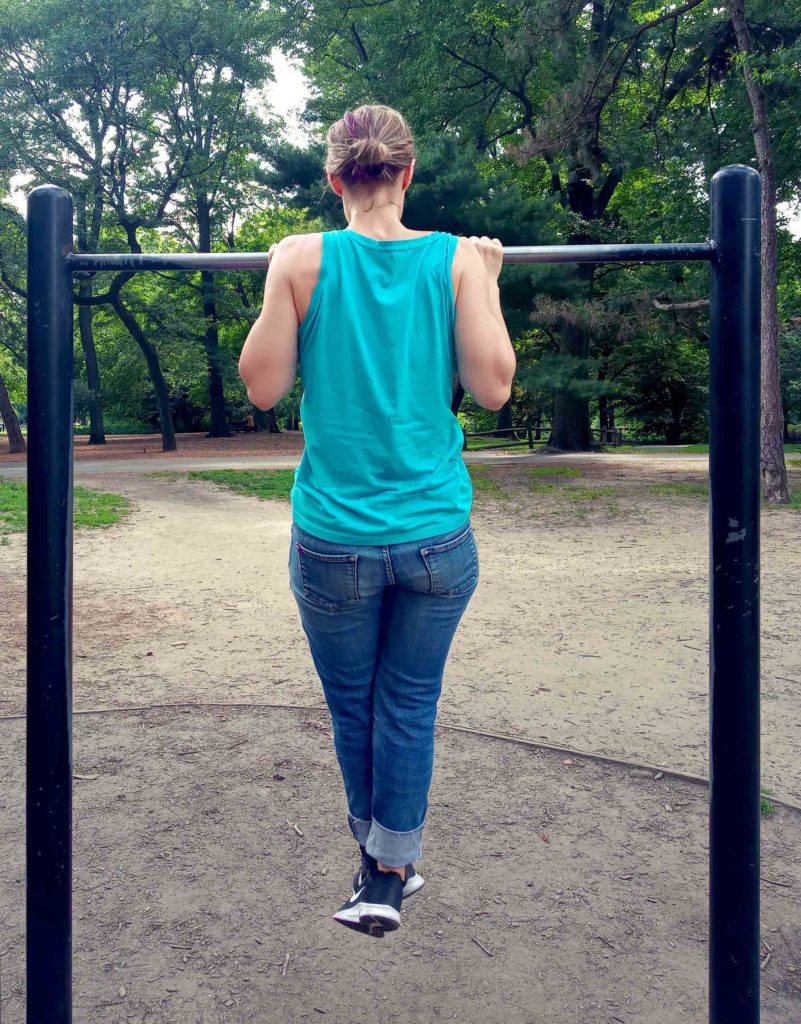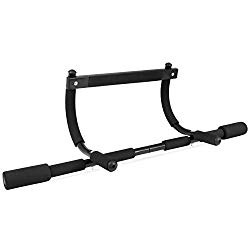
You can learn to do a pull-up.
You can.
Seriously, you can.
I know because I’ve been there. I started doing pull-ups because I got really into aerial silk at one point. If you haven’t heard of aerial silk, here’s a taste. I became obsessed after seeing a circus show that featured aerial arts and started taking classes.
I adored it, except for one thing: I was limited by my physiology. Most of being able to do aerial arts requires you to be able to lift yourself from a hanging position and hold it.
Thus began my venture to learn the pull-up. I eventually had to stop taking aerial classes (I still miss it), but I will never, ever lose the ability to do a pull-up, if I can help it.
Should you learn a pull-up?
Why would you want to learn it? Well, the pull-up is probably the most difficult bodyweight exercises there is, besides maybe its older sister the muscle-up, or a freestanding one-handed handstand (is that even possible?). Being hard means it works you. It means it burns energy. It also means it looks hella impressive.
Pull-ups work your entire body, and work it hard, giving you the ultimate Badass Badge. Not only are you turning your body into a fat-burning machine, but you’ll also develop amazing abs, back and arms, and you’ll get incredible bragging rights.
If you’re doing an upper body bodyweight workout, every exercise will be a variation of a push-up or a pull-up. push-ups are amazing, and perhaps my favorite exercise of all time, but you need balance. Pull-ups will work your back, which push-ups don’t. They’ll also give you variety in your workout movements, reducing the risk of overuse and giving you a more healthy, balanced physique.
The only way to learn is to do it.
There isn’t a way to learn a pull-up by only training those muscles. You need to do pull-ups, and if you can’t do pull-ups yet, you approximate or make it easier. Even large, bulky men who do overhead pulls on the machine at the gym cannot do pull-ups from that training alone. Why? Because it requires much more than just strength in a couple big muscles. It requires stamina, mental and physical, coordination, and tons of little tiny muscles all over your body.
DO IT.
- Get a pull-up bar and install it in your house.
- Practice. If you can’t do one, do a method that approximates (see below).
- Incorporate them into your routine.
I use this one (pictured left), which is great because it doesn’t ruin your door frames if you’re a renter (like me). If you have soft wood on the frames, you might want to pad it with some towels, though.
Hang out.
The first thing you need to learn is how to hang. You need to hang with your shoulders engaged. The difference between shoulders not engaged (check the red section between the neck and shoulders/upper arms):

And engaged:

When you engage your shoulders, your shoulder blades should be down and your neck is suddenly visible. Practice disengaging and engaging on a pull-up bar until you feel comfortable.
Reverse pull-ups.
The concept is simple: start in the top-most pull-up position and lower yourself to hanging. You might be able to jump up, or you might need a chair or stool. But once you do, try lowering yourself at a relatively slow rate, rather than quickly dropping down. Being deliberate will work the muscles you need to gain in order to do a regular pull-up, but also it will ensure your safety.
Almost-pull-ups.

Hang, engage your shoulders, and then…try. That’s it. Just try. Engage the muscles.
There is a very strong chance you won’t get anywhere. That’s okay! Even if your arms are almost completely straight and you’re not any closer to the bar, you’re still activating the muscles. The pull-up is a complicated exercise and a big part of mastering it is getting the coordination down. It may feel like failure—it’s not. It’s so not. Just keep it up.
Assisted pull-ups.
There are a few ways to do assisted pull-ups, but my favorite way is by placing a chair underneath the bar and using it when you need a lift up. This will be very helpful when you’ve gotten a little further on the almost-pull-ups, and can lift yourself a bit, but can’t get over that middle section. Just lightly put your foot on the chair and ease yourself up. Ideally, only use as much assistance as you need. I find that once you get over that middle section, usually just below the bar, it gets a little easier.
Other ways of doing assisted pull-ups are jumping up, putting a resistance band on the bar or using a machine with built-in assistance.
Exercises to help with pull-ups.
Your main focus should be the methods above. It’s much, much harder to try to do a pull-up without doing a pull-up motion. Working the muscles that are used in pull-ups only will most likely not bring you the goal of being able to do pull-ups… if done alone.
If you would like to do supplementary exercises, I suggest focusing on the latissimus dorsi (lats), the major muscle involved in the pull-up. I suggest the best one is the Aussie pull-up (also called the down under, supine row, reverse push up, and many other things) because the motion resembles a regular pull-up. Grab a bar or handles or rings about two to three feet off the floor and hang underneath it, keeping your shoulders engaged and your back and neck straight. You can keep your legs straight, which is a bit harder, or bend your knees at a right angle. Pull yourself up towards the bar as far as you can, and lower back to the starting position.
Bent-over rows and variations of it are also good for the lats. Again, use these only to supplement simulating the pull-up in some way.
Keep it up!
By having one in your house, you can casually try one every once in a while. Just keep trying. Pull-ups feel ridiculously hard, but I promise you, it’s a four-minute mile. Once you do ONE, you will find that you can much more easily keep doing one, and then adding two, three, or more.
I love adding pull-ups to my workout routines, so learn them and follow along! Let me know how you’re doing!


